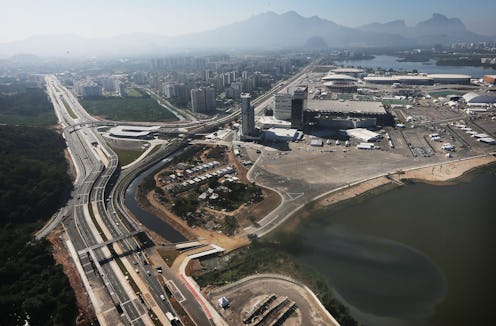News
Check Out NASA's Satellite Photos Of Rio
Rio's Olympic Games are in full force as 10,000 athletes from around the world traveled to the Brazilian city last week to compete, and the games are certainly off to a strong start for some. However, just days before the 2016 Olympics opening ceremony, NASA was recording imagery of Rio and the surrounding region with a satellite that passed over the city. And what NASA's satellite imagery of Rio found reveals something troubling.
The satellite used what's called a Multi-angle Imaging SpectroRadiometer (MISR) to collect the images, which were used to measure the level of particulate matter in the atmosphere — or in simpler terms, to estimate the level of air pollution just ahead of the games. The device measures the pollutants, which are "tiny airborne droplets or pieces of soot and dust that can end up in the lungs," and which is a problem facing many cities around the world that struggle with poor or polluted air quality, according to NASA.
The imagery measures and displays the "aerosol optical depth" — which measures "how much incoming light from the sun is blocked" by air pollution — of the coastal waters and inland in Rio and the surrounding region. The levels varied between values of 0.15-0.25. For reference, NASA's report suggests that a light haze corresponds to "an optical depth of 0.2.," noting that Rio's optical depth is "slightly elevated compared to its surroundings, most likely due to the presence of air pollution." The highest value on the scale is 0.3 so Rio's optical depth is definitely up there.
Check out the imagery below:
The lefthand image shows the satellite imagery of Rio on the coast, and the surrounding area — the black asterisk marks the Maracaña Stadium, where the opening ceremony was held, according to the NASA report. The report suggests that the "elevated levels of particulate matter" were present in the region for weeks leading up to the August 5 opening ceremony.
In order to host such a wide-scale sporting event, the World Health Organization (WHO) reportedly offers public health guidelines to which the hosting city is supposed to adhere. When Brazil entered the bid to host the Olympics, the country reportedly claimed that the air quality was "within the limits recommended by the World Health Organization," according to Reuters. Reuters also noted that the claim was false in 2009 when Rio won the bid and it remains false at this point. And based on NASA's satellite imagery, it would appear that the air quality is probably not within those limits.
In fact, according to the Reuters report on Rio's air pollution levels, it found that based on statistics from the city's environmental protection agency, called Inea, "Since 2011, Rio's [particulate matter] 2.5 levels surpassed WHO's annual limits 83 percent of the time."
Unfortunately, and as Reuters also noted, while the Olympic athletes from around the world only have to experience Rio's air pollution during the two-week period of competitive sporting events, the rest of the city's occupants will still be living with high levels of particulate matter even after the games are over. And for them, it's especially important to work toward clean air.
Image: NASA/GSFC/LaRC/JPL-Caltech, MISR Team (1)
